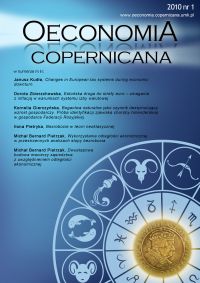Abudance Of The Natural Resources As A Factor, Which Destimulates Economic Growth. Looking For The Dutch Disease In Russia
DOI:
https://doi.org/10.12775/OeC.2010.003Keywords
The Dutch Disease, natural resources, resource movement effect, spending effectAbstract
In general thinking, countries possessing rich natural resource deposits are blessed, as resource abundance has seemingly positive correlation with the wealth and economic development of a nation. However, experience shows that countries endowed with extreme amounts of natural resources have found themselves in a serious misuse and on a damaging growth path. Extraordinary resource possession is rather an opportunity than a guarantee for better economic performance. The term “Dutch disease” refers to a situation in which new discoveries of natural resources or sharp rises in commodity prices lead to an increase in the equilibrium real exchange rate, thus undermining the competitiveness of the other tradable sectors in the economy. As suggested in the academic literature the Dutch disease is associated ith four main symptoms: a slowdown in manufacturing output, a booming non-tradable sector, an increase in real wages and real exchange rate appreciation. Russia’s oil price dependence and the risk of the Dutch disease are often considered as the main long-term challenges to sustainable growth in the country. In this regard, it is worth studying the available economic data for evidence of these phenomena. Russia’s oil price dependence and the risk of the Dutch disease are often considered as the main long-term challenges to sustainable growth in the country. In this regard, it is worth studying the available economic data for evidence of these phenomena. The main section examines whether in Russia: exports have become more biased towards oil and gas, GDP growth has become more sensitive to oil price fluctuations, the economy is showing symptoms of the Dutch diseaseReferences
Ahrend R. (2004) Russian Industrial Restructuring, Trends in Productivity, Competitiveness and Comparative Advantage, “OECD Economics Department Working Papers”, nr 408.
Ahrend R. (2006), Russia`s Post-Crisis Growth: Its Sources Prospects for Continuation, “Europa-Asia Studies”, nr 1.
Bank Centralny Federacji Rosyjskiej, www.cbr.ru(2.06.2009).
Becker D., Gundlach E. (2005), Notes on Factor Price Equality and Biased Technological Change in a Two-Cone Trade Model, Rostock University and Kiel Institute for World Economics, s. 3.
BP (2009), www.bp.com (2.06.2009).
Corden W.M., Neary N.P. (1982), Booming Sector and De-Industrialisation in a Small Open Economy, “The Economic Journal”, nr 368.
Gylfason T. (2001), Lessons from the Dutch Disease: Cause, Treatment, and Cures, “Institute of Economic Studies Working Paper Series”, nr W01:06.
International Energy Agency (2009), www.iea.org (6.06.2009).
International Monetary Fund (2003), Russian Federation: Statistical Appendix, “IMF Country Report”, nr 03/145.
International Monetary Fund (2006), Russian Federation: Statistical Appendix, “IMF Country Report”, nr 06/431.
Krugman P. (2000), Technology, Trade and Factor Prices, “Journal of International Economics”, nr 50.
Lane P., Tornell A. (1996), Power, Growth, and the Voracity Effect, “Journal of Economic Growth”, nr 1.
Lane P., Tornell A. (1998), Voracity and Growth, NBER Working Paper, nr 6498.
Mauro P. (1995), Corruption and Growth, “Quarterly Journal of Economics”, nr 90.
Neary J.P. (1978), Short-Run Capital Specificity and The Pure Theory of International Trade, “The Economic Journal”, nr 351.
Ministry of the Russian Federation for Economic Development and Trade (2008), On the Current Economic Situation in the Russian Federation as Based on January 2008 Results, Moskwa.
Oomes N., Kalcheva K. (2007), Diagnosing Dutch disease: Does Russia have the symptoms?, “Bank of Finland Discussion Papers”, nr 7.
Rosstat, www.gks.ru (1.06.2009).
Sala-i-Martin X., Subramanian A. (2003), Addressing the Natural Resource Curse: An Illustration from Nigeria, “NBER Working Paper”, nr 9804.
Sosunow K., Zamulin O. (2006), Can Oil Prices Explain the Real Appreciation of the Russian Ruble in 1998-2005?, “CEFIR/NES Working Paper”, nr w0083.
The World Bank (2004), Russian Economic Report February 2004, “The World Bank Working Paper”, nr 35598.
Wijnbergen S.V. (1984), Inflation,Employment, and The Dutch Disease in Oil-Exporting Countries: A Short-Run Disequilibrium Analysis, “The Quarterly Journal of Economics”, nr 2.
Downloads
Published
How to Cite
Issue
Section
Stats
Number of views and downloads: 671
Number of citations: 0



